The 'Jungen Wilden' – German Art of the 1980s
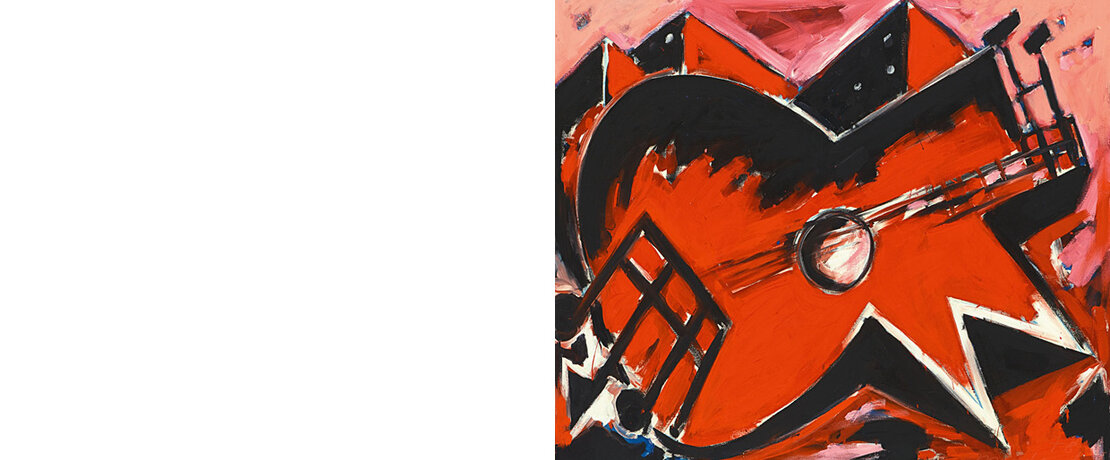
The 'Jungen Wilden' – Table of contents
- Europe '79 - The beginning of a groundbreaking development
- Groupings of the "Jungen Wilden"
- "Die Gitarre" by Helmut Middendorf
- Werner Büttner and his critique of art and society
- Monumental Views by Andreas Schulze
- Walter Dahn - The energetic pragmatist
- Insights into the art scene of the 1980s through works by Oehlen and Trockel
Europe '79 - The beginning of a groundbreaking development
It was first in the 1979 exhibition “Europa ‘79”, held in Stuttgart, that a ground-breaking development in contemporary art became visible, represented by Italian and German artists, displaying a turn towards a representational, subjective painting featuring multiple (self) references, with signs, symbols and quotations. Carried by an optimistic atmosphere of departure, groups of young painters came together in the 1980s in Berlin, the Rhineland and Hamburg and presented their innovative outlook on art to the public.
Groupings of the "Jungen Wilden"
In Berlin, for example, Rainer Fetting, Salomé, Helmut Middendorf and Bernd Zimmer took part in a group show entitled “Heftige Malerei”, whilst in Cologne, Peter Adamski, Walter Dahnand Jiři Georg Dokoupil, amongst others, found common ground under the name of “Mülheimer Freiheit”. The “Jungen Wilden”, as they were generically titled, stood for an integrated view of art in which contemporary music and literature also built important points of reference. In their works, fantasy and reality, history and the present, sensuality and intellect, irony and seriousness, provocation and kindness are not mutually exclusive. This auction offers six works from this pioneering period, all of which were displayed in the large overview exhibition “Tiefe Blicke. Kunst der achtziger Jahre aus der Bundesrepublik Deutschland, der DDR, Österreich und der Schweiz“, held in 1985 in the Hessisches Landesmuseum Darmstadt.
"Die Gitarre" by Helmut Middendorf
“Die Gitarre” by Helmut Middendorf, painted in 1978 (lot 555) and therefore the earliest work of this selection, is testimony to the musical affinity of the “Jungen Wilden” in general and for Middendorf in particular. Shortly before his move to Berlin in 1973, the artist stood before the decision whether to become a musician or a painter and would go on to dedicate a whole series of works to the electric guitar in 1977-79.
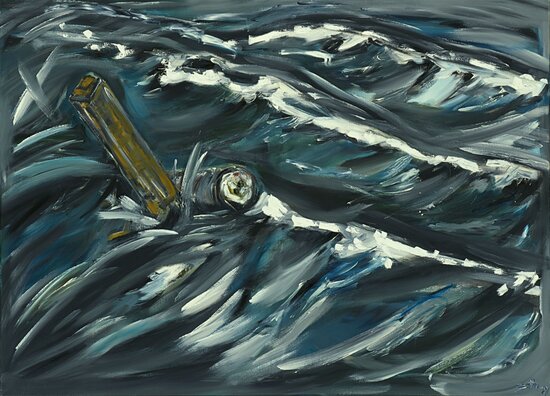
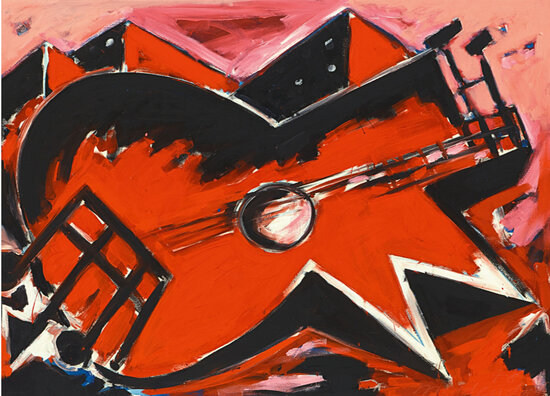
Werner Büttner and his critique of art and society
Together with Albert Oehlen and Martin Kippenberger, Werner Büttner propagated a cryptic, socio-critical and art-critical claim in Hamburg, not from the position of the critical observer, but from the party concerned. “Immerse yourself in what is there and let it rub off on the canvas. Basically, we are mostly uninvolved in the whole story. We read the paper in the morning and paint in the afternoon. This state is responsible for the result.” (Albert Oehlen, quoted in exhib.cat. Tiefe Blicke, p. 56). Even Büttner’s seemingly banal motif “Rundholz trifft Kantholz im Atlantik” from 1981 must be read with this in mind (lot 554).
Monumental Views by Andreas Schulze
The Düsseldorf artist Andreas Schulze began with landscape paintings which he further developed from 1981 under the influence of abstract pictorial concepts such as those by E. W. Nay or Victor Vasarely into monumental, stage-like views such as “Wolke” from 1982 (lot 556). His forms oscillate between the real image and non-representational. Moreover, Schulze’s pictures undermine the renunciation of a pictorial space demanded by abstraction through their deep spatial perspective.
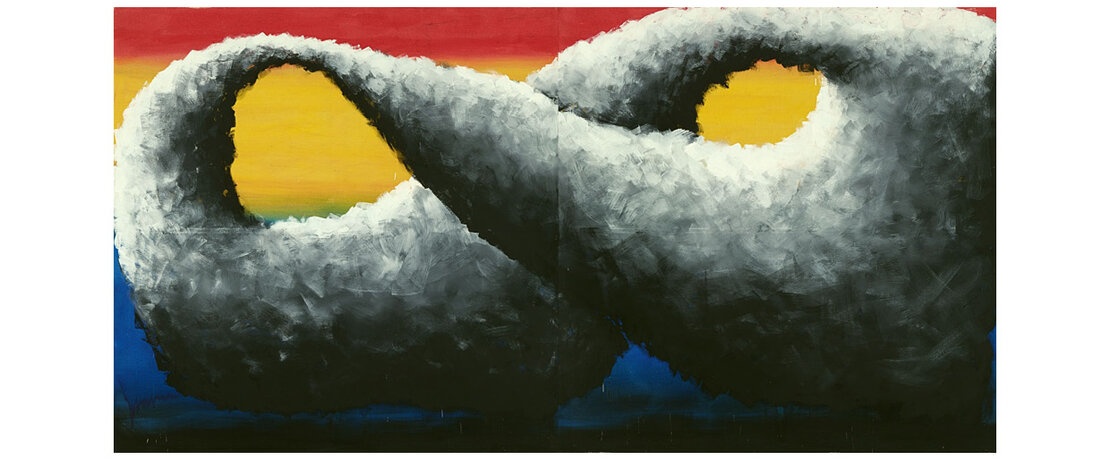
Walter Dahn - The energetic pragmatist
Walter Dahn is the energy-laden pragmatist of the “Mülheimer Freiheit”. He developed his surreal pictorial ideas during the painting process, as is clearly seen in “Mann mit großer Nase” (lot 552) and “Handwerker, 2. Version” (lot 553), in particular, in its visibly swift execution. “What fascinated me was that he was a man of action: an idea, and it was immediately realised. Immediately. At that time, I would have had to make weeks of preparations before a picture was created”, his close friend Georg Dokoupil expressed in admiration (quoted from exhib.cat. Tiefe Blicke, p. 75). At the same time, there was a trend towards a “wild” subjective-expressive art in the GDR. The Leipzig artist Hartwig Ebersbach expressed himself in painterly self-questioning of extraordinary radicalism, as “Galion I” from 1982 illustrates (lot 559).
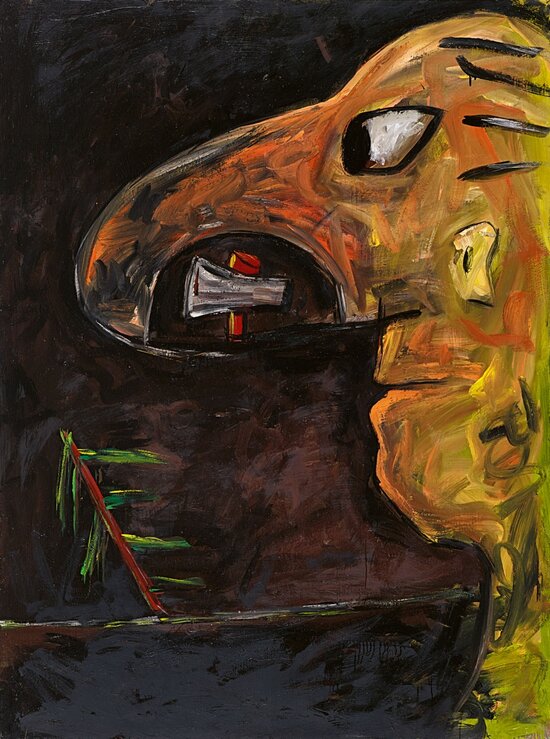
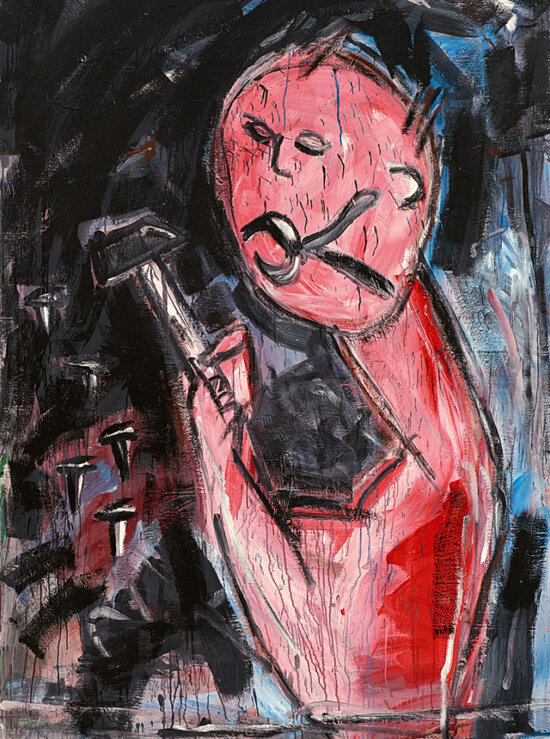
Insights into the art scene of the 1980s through works by Oehlen and Trockel
From the same collection as the six Tiefe Blicke works, comes “Pfeifenbild” by Albert Oehlen from 1982 (lot 558). Close friends with Martin Kippenberger and Werner Büttner at that time, Oehlen combined painting, photography and real pipes in a collage in which he simultaneously celebrated and ironised the dandy gesture of the artist clique. He thereby provided an impressive example of the “cool” strategy of the subculture of the time. Rosemarie Trockel’s “Ohne Titel” (lot 557), also from the collection, provides a counterpoint to this. Trockel was one of the few female representatives of the up-and-coming young “wild” artists of the scene in the early 1980s. She thematised and ironised subjects and activities associated with the conventional female role model, such as the cooking hob and knitting, creating drawings and oil works which repeatedly captured household and kitchen objects, as in the work “Ohne Titel” from 1984.
Auction 1163 - Day Sale Contemporary Art - Wednesday, December 9 at 11 am in Cologne
Preview in Cologne - Friday, November 27 until December 7 by appointment
